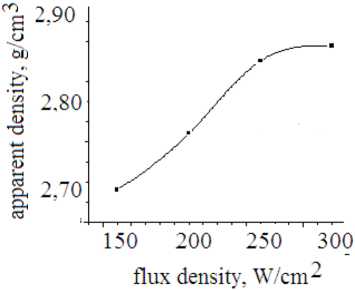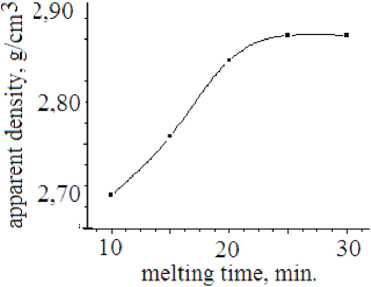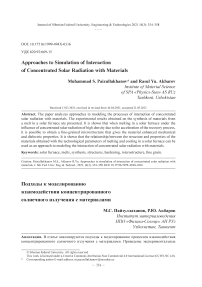Approaches to simulation of interaction of concentrated solar radiation with materials
Автор: Paizullakhanov Muhammad S., Akbarov Rasul Yu.
Журнал: Журнал Сибирского федерального университета. Серия: Техника и технологии @technologies-sfu
Статья в выпуске: 3 т.14, 2021 года.
Бесплатный доступ
The paper analyzes approaches to modeling the processes of interaction of concentrated solar radiation with materials. The experimental results obtained on the synthesis of materials from a melt in a solar furnace are presented. It is shown that when melting in a solar furnace under the influence of concentrated solar radiation of high density due to the acceleration of the recovery process, it is possible to obtain a fine-grained microstructure that gives the material enhanced mechanical and dielectric properties. It is shown that the relationship between the structure and properties of the materials obtained with the technological parameters of melting and cooling in a solar furnace can be used as an approach to modeling the interaction of concentrated solar radiation with materials.
Solar furnace, melts, synthesis, structures, hardening, microstructure, fine grain
Короткий адрес: https://sciup.org/146281799
IDR: 146281799 | УДК: 620.92:669-15 | DOI: 10.17516/1999-494X-0316
Текст научной статьи Approaches to simulation of interaction of concentrated solar radiation with materials
Цитирование: Пайзуллаханов, М.С. Подходы к моделированию взаимодействия концентрированного солнечного излучения с материалами / М.С. Пайзуллаханов, Р.Ю. Акбаров // Журн. Сиб. федер. ун-та. Техника и технологии, 2021, 14(3). С. 354–358. DOI: 10.17516/1999-494X-0316

Fig. 1. Dependence of apparent density of pyroxene material samples on flux density

Fig. 2. Dependence of the apparent density of pyroxene material samples on the melt holding time at 300 W/cm2

Fig. 3. Dependence of the abrasipn of the pyroxene material on the flux density
Powders <5 microns in size were obtained, and ceramics based on them are characterized by an unusual change in heat resistance and mechanical strength.
The use of solar energy in relation to the production of materials of higher refractoriness was first carried out by Japanese and French scientists. For this purpose, small-capacity Solar Furnaces were built in Japan, and subsequently, taking into account this experience, the Large Solar Furnace was created in France. The results obtained by French researchers were quite interesting and promising from both a scientific and a practical point of view. In the scientific plan, oxide and some non-metallic systems with melting points above 2000 °C in an oxidizing atmosphere were studied, which is difficult to achieve using traditional techniques. It was found that as a result of exposure to solar radiation, the mechanical, optical characteristics and a number of other functional parameters of materials are significantly improved.
Despite the many years of experience and sufficient scientific and experimental material in this area, little attention has been paid to the study of the physical foundations of the processes of interaction of concentrated solar radiation with matter and the mathematical modeling of these processes.
Studies and literature analysis showed that knowledge of the physical basis of the processes of interaction of concentrated solar radiation with matter plays an important role in the synthesis and heat treatment of materials. However, due to the complexity, this problem has not been practically studied; there is very scarce data both in terms of interpreting physical processes and in terms of constructing a mathematical model. Therefore, the study of this problem is an urgent task of our time.
It should be noted that the structure of substances cannot yet be fully described, statistical parameters (enthalpy, entropy) do not allow tracking the local evolution of a substance under the influence of radiation, although it has long been proposed to transfer the formalism of the coherence theory to the description of matter [5]. For radiation, in such experiments as interference, diffraction, polarization, dispersion, the wave properties of light are manifested and wave characteristics are used to describe light: λ, ν (spectral composition of radiation). In the effects of quantum optics, such as thermal radiation, the photoelectric effect, the photochemical effect of light, the pressure of light, the Compton effect, light manifests itself as a particle and particle characteristics are used to describe it – mass, momentum. The development of optics, the totality of optical phenomena, showed that the continuity properties characteristic of the electromagnetic field of a light wave should not be opposed to the discrete properties characteristic of photons. Light has complex wave-particle properties, i.e. possesses both wave and quantum properties – particle-wave duality (duality) of the properties of light. As for matter, in some cases its quantum nature is manifested – under the influence of the radiation field, transitions occur between the energy levels of the particles of which this substance consists. This usually occurs when the radiation frequency coincides with the transition frequency.
The same effects occur during interband absorption in semiconductors and dielectrics, when electron-hole pairs are produced, or during impurity absorption, when an electron is generated in the conduction band or a hole in the valence band. In this case, one has to resort to a quantum-mechanical description. If the quantum nature of the substance does not appear, then it is much easier to consider on the basis of the classical description, using macroscopic characteristics, such as dielectric constant, magnetic constant, conductivity, etc. When it comes to the interaction of radiation with matter, a semi-classical description is often used: the substance is considered as a quantum system and the corresponding physical quantities are replaced by operators, and the radiation field is considered classically, based on Maxwell’s equations.
The main problem is, of course, the lack of a single formalism for the simultaneous description of both matter and radiation. This is especially true for the situation when the phenomenon occurs in the region that is transitional from quantum-mechanical to classical scales, which is characteristic of most optical phenomena, as was recently shown in the modern theory of quantum measurements [6]. Hence the complexity of the problem. In this sense, the problem of creating a theory of the process of the interaction of radiation with matter is very far from its solution.
It is well known that the electromagnetic field in any medium in the classical description is determined by setting the vectors of electric strength E and magnetic H fields, as well as vectors of electric D and magnetic induction B (Maxwell’s equation). The Maxwell equations themselves do not form a closed system, on the basis of which it would be possible to calculate the fields in the crystal. These equations reflect only the influence of the crystal on the propagation of electromagnetic radiation in it. In its most general form, this dependence is determined by the equations of quantum mechanics that describe the effect of an electromagnetic field on the motion of crystal charges. However, the solution of these equations and finding on their basis the functional relationship between the physical characteristics of the crystal and the field strengths is a very difficult task.
One of the options for constructing the achievement of such a goal may be to use the formalism of statistical physics and fluid theory. By the way, we note that the use of the theory of integral, and, in particular, Fourier, transformations in statistical physics and fluid theory allows us to talk about an analogy between the phenomena described in them with the processes of wave field formation in Fourier optics and apply a number of results , for example, in computer optics [7].
Thanks to the advent of lasers, the theory of the interaction of radiation with substances received a certain impetus to development. For some types of lasers and substances, mathematical models of these processes have been developed. The literature contains the development of a mathematical model and an algorithm for calculating the temperature distribution in complex multilayer systems under the influence of laser radiation. These models are based on the finite-difference method and take into account the anisotropy of the optical and thermal parameters of the structure of materials. Typically, the model is two-dimensional and non-stationary and allows you to simulate the interaction of various types of laser with substances.
Список литературы Approaches to simulation of interaction of concentrated solar radiation with materials
- Akbarov R.Yu., Paizullakhanov M.S. Characteristic Features of the Energy Modes of a Large Solar Furnace with a Capacity of 1000 kW. Applied Solar Energy, 2018, Vol. 54, No. 2, 99-109.
- Payzullahanov M.S. Particularities of the syntheses BaTiO3 in the field of concentrated light energy. Horizon Research Publishing, USA Manuscript ID: 16200286. 2013, No. 27.
- Paizullakhanov M.S., Nurmatov Sh.R., Shermatov Zh.Z. Barium and strontium titanites synthesized in a field of concentrated light energy. Glass and ceramics. 2013, No. 6, p. 123-125.
- Paizullakhanov M.S., Faiziev S.A., Nurmatov S.R., Shermatov Z.Z. Synthesis features of barium titanite in the field of concentrated light energy. Applied Solar Energy 49(4), 248-250.
- Delone N.B. The interaction of laser radiation with matter. M.: Science, 1989. 280 p.
- Kadomtsev B.B. Dynamics and information. 2-nd ed. M.: Editorial Board of Uspekhi Fizicheskikh Nauk, 1999. 400 p.
- Soifer V.A., Kotlyar V.V., Doscolovich L.L. Iterative methods for diffractive optical elements computation. London: Taylor & Francis Ltd., 1997. 240 p.


